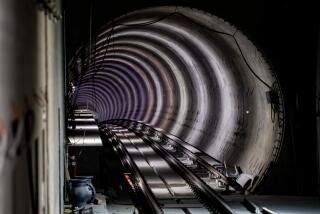BART on Track : 15-Year-Old System Overcomes Technical Glitches, Still Has Critics
SAN FRANCISCO — From the day the Bay Area Rapid Transit system opened, it became a contemporary case of what Mark Twain dubbed “modern inconveniences.”
Its computerized whiz-bang control systems created “ghost trains,” left hapless commuters stranded on platforms and sent one train flying off the tracks and into a parking lot.
As BART marks its 15th anniversary this month, the system has solved most mechanical problems, has an enviable safety record and is beginning to live up to claims for its Jules Verne technology, directors say.
The electric rail system has begun a $491-million expansion, adding 150 French-built cars, $20 million in fireproofing and a new train control system to replace the first-generation computer blamed for BART’s early failures.
Grandiose Plan Considered
BART’s board of directors is even considering a grandiose scheme to run 300-m.p.h. magnet-powered trains beyond the San Francisco Bay Area.
“BART is entering a new era,” said Bill Heins of the Metropolitan Transportation Commission, which watches over public transportation in the area. “There is large public and political support for extensions. . . . BART is now part of the landscape.”
Critics concede that BART has helped ease traffic congestion, but maintain that it has never justified astronomical costs and after 15 years has proved that electric rail mass transit isn’t practical in the automobile-based cities of the West.
BART’s 440 sleek, aluminum cars run along 71 miles on an X-shaped route that takes trains east of San Francisco and then north and south, connecting affluent suburbs to San Francisco’s financial district and bustling ethnic neighborhoods.
Carpeted trains as luxurious as modern aircraft carry suburban executives under San Francisco Bay into the city in an average time of 3 minutes, 45 seconds, down from 6 to 12 minutes a decade ago.
‘Much More Comfortable’
“I can read on BART and I could never do that on the Boston subways,” said Mary Bradelis, a 27-year-old San Francisco shop clerk. “BART is high tech; it’s much more comfortable than the old subways . . . it’s cushy.”
Hank White of Local 1555 of the Amalgamated Transit Union, representing BART’s train operators and station agents, says the system has been a fair employer, although BART concedes that it is 15% below goals for hiring women and minorities.
General Manager Keith Bernard said BART’s successful record is the reason voters approved extensions to be built by 1990 in Alameda and San Mateo counties. BART’s unfunded plan calls for extensions to the General Motors-Toyota joint venture plant in Fremont and south to the Silicon Valley section of Santa Clara County. And it is working on a “common ticket” that will link the AC Transit regional bus system, the San Francisco Municipal Railway and BART into one of the most convenient mass transit systems in the country, Bernard said.
The hope is that expansion will lure back riders lost since October, when gasoline prices fell and ridership dropped from 210,000 a day to 196,000, Bernard said.
Disastrous Accident
BART lost the confidence of some riders on Jan. 17, 1979, when a train stalled in the tunnel under the bay and caught fire. The damage caused by BART’s worst accident took 11 weeks to undo. One firefighter died and 44 people, including firefighters and fleeing passengers, were injured.
It cost BART millions to replace material in all trains that gave off lethal fumes during the blaze.
BART’s problem now is not technology. It’s money, said spokesman Sy Mouber. “We know where to go and how to build it and how to operate it,” said Mouber. “The problem now is money, pure and simple.”
BART cost $1.38 billion to build, of which $792 million came from bonds approved by voters in 1962. During the 1985-86 fiscal year, it received $84.2 million from 75% of the one-half cent added to the sales tax in its three counties, Alameda, Contra Costa, and San Francisco. Fares added $73 million.
Despite subsidies, BART faces a $4.4-million to $28.6-million deficit next year and still can’t control spiraling costs. Cost of the new computerized “dispatcher” system has escalated from $16 million to $36 million, prompting state Sen. Quentin L. Kopp (I-San Francisco) to open an inquiry by the state auditor general.
Fares Increased
To make extra money, directors approved a fare increase which, since January, 1986, has raised the cost of a trip from suburban Concord--the last stop on the eastbound Concord line--to San Francisco to $2.65 each way, and BART is considering charging a $30-a-month parking fee to commuters.
And promises remain unfulfilled. Voters in eastern Contra Costa County have been paying property taxes since 1962 but have no line into the cities of Antioch and Pittsburg, both a few miles beyond Concord. And BART remains below its promise
of serving 250,000 riders a day by 1975.
According to Melvin M. Webber of the Institute of Urban and Regional Development at the University of California, Berkeley, BART has proved electric railways are not the answer in Western cities.
“It was a mistake. They should have used a different technology,” Webber said. “Buses given exclusive right of ways at certain times would have offered better pickup and delivery.”
But without BART, traffic across bridges spanning San Francisco Bay would be unendurable, Bernard said. Buses and BART carry 52% of all the people who cross the bay.
“The bridge would not be able to handle them all (in cars),” he said.
“Some people believe in (BART),” Webber said. “It’s a symbol of modernity, of civic development. It is a symbol of progress.”
More to Read
Sign up for Essential California
The most important California stories and recommendations in your inbox every morning.
You may occasionally receive promotional content from the Los Angeles Times.










